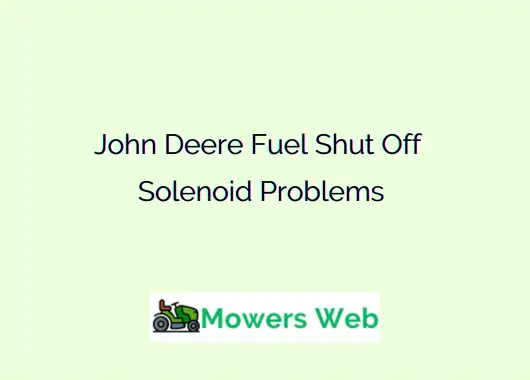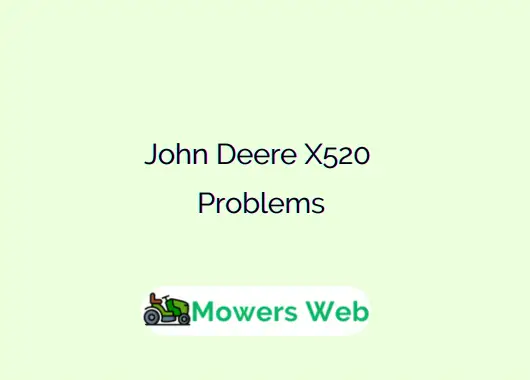In this post, we’ll explore the fuel shut-off solenoid, common problems associated with it, symptoms to watch for, and practical solutions to keep your John Deere equipment running smoothly.
John Deere Fuel Shut Off Solenoid Problems
1. Electrical Failures: The solenoid relies on electrical current to function. Faulty wiring, loose connections, or a failed solenoid coil can prevent the valve from opening or closing properly. Corrosion or damaged wiring harnesses, often caused by exposure to moisture or debris, are common culprits.
2. Solenoid Coil Burnout: Over time, the solenoid’s internal coil can overheat or burn out due to prolonged use, electrical surges, or manufacturing defects. A burnt-out coil renders the solenoid inoperative, halting fuel flow.
3. Sticking or Jamming: The solenoid’s valve can become stuck due to dirt, debris, or fuel contamination. This prevents the valve from moving freely, causing either constant fuel flow (failing to shut off) or no fuel flow at all (failing to start).
4. Fuel Contamination: Diesel fuel can accumulate water, dirt, or other contaminants, which may clog the solenoid or cause corrosion. This is particularly problematic in older John Deere models where fuel filtration systems may not be as robust.
5. Wear and Tear: Like any mechanical component, the solenoid is subject to wear over time. Continuous use, especially in harsh agricultural environments, can degrade seals, springs, or the valve itself, leading to inconsistent performance.
Related John Deere Electric Clutch Problems(5 Causes + Solutions)
Solutions and Repairs
- Clean the Solenoid: If contamination is the issue, disassemble and clean the solenoid with a suitable solvent. Ensure all debris and corrosion are removed, and replace any damaged seals.
- Replace Faulty Wiring: Repair or replace damaged wiring or connectors to restore proper electrical function.
- Replace the Solenoid: If the coil is burnt out or the valve is irreparably damaged, replace the solenoid with a genuine John Deere part or a high-quality aftermarket equivalent. Ensure compatibility with your model.
- Improve Fuel Quality: Use high-quality diesel fuel and regularly replace fuel filters to prevent contamination. Consider adding a fuel stabilizer to reduce water buildup.
- Regular Maintenance: Incorporate solenoid checks into routine maintenance schedules. Inspect for wear, clean connections, and test functionality to catch issues early.
Related John Deere Power Reverser Transmission Problems(Fixed)
Symptoms of a Faulty Fuel Shut Off Solenoid
- Engine Won’t Start: If the solenoid fails to open the fuel valve, no fuel reaches the engine, resulting in a failure to start. You may hear the starter motor engage, but the engine won’t turn over.
- Engine Won’t Shut Off: A solenoid stuck in the open position may allow fuel to flow continuously, preventing the engine from stopping even when the ignition is turned off.
- Intermittent Power Loss: A partially functioning solenoid may cause erratic fuel delivery, leading to power loss, sputtering, or stalling during operation.
- Fuel Leaks: A damaged or stuck solenoid can cause fuel to leak from the system, noticeable as wet spots or a strong diesel odor around the equipment.
- Unusual Noises: A faulty solenoid may produce clicking or buzzing sounds when attempting to engage, indicating electrical or mechanical issues.
If you notice any of these symptoms, it’s critical to inspect the fuel shut off solenoid promptly to avoid further complications.
Related John Deere Fuel Filter Not Full(3 Quick Ways To Fix)
Diagnosing the Problem
1. Check Electrical Connections: Inspect the solenoid’s wiring and connectors for signs of corrosion, looseness, or damage. Use a multimeter to test for proper voltage at the solenoid when the ignition is turned on.
2. Test the Solenoid Coil: Measure the resistance of the solenoid coil with a multimeter. Compare the reading to the manufacturer’s specifications (found in the equipment’s service manual). A significantly high or low resistance indicates a faulty coil.
3. Inspect for Contamination: Remove the solenoid and check for debris, rust, or fuel contamination. Ensure the fuel system, including filters, is clean.
4. Manual Operation Test: Some solenoids allow manual operation to test valve movement. If the valve is stuck, cleaning or replacement may be necessary.
5. Consult Error Codes: Modern John Deere equipment may display diagnostic codes related to fuel system issues. Use a diagnostic tool to retrieve these codes for further insight.
Related Accidentally Put Gas/Oil Mix in Lawn Mower(5 things To Do)
What is a Fuel Shut Off Solenoid?
The fuel shut-off solenoid is an electromechanical device in diesel engines, including those in John Deere tractors and mowers. Its primary function is to control the flow of fuel to the engine, allowing it to start or stop as needed.
When the ignition is turned on, the solenoid receives an electrical signal that opens a valve, permitting fuel to flow to the engine. When the ignition is turned off, the solenoid closes the valve, cutting off the fuel supply to stop the engine. This precise control is essential for efficient engine operation and safety, preventing fuel leakage or unintended engine running.
In John Deere equipment, the fuel shut off solenoid is typically found in diesel-powered models, such as tractors, combines, and certain lawnmowers. Given its critical role, any malfunction can significantly disrupt equipment performance, leading to downtime and costly repairs if not addressed promptly.
Related John Deere Buck 500 Problems(5 Common + Solutions)
Preventing Future Issues
Preventive measures can extend the life of your fuel shut off solenoid and minimize downtime:
- Routine Inspections: Regularly inspect the fuel system, including the solenoid, for signs of wear or damage.
- Proper Storage: Store equipment in a dry, sheltered environment to protect electrical components from moisture.
- Fuel System Maintenance: Use clean fuel, replace filters as recommended, and drain water from the fuel system periodically.
- Follow Manufacturer Guidelines: Adhere to John Deere’s maintenance schedules and use genuine parts for replacements.
Final words
The fuel shut off solenoid is a small but vital component in John Deere equipment, and its failure can lead to significant operational challenges. By understanding common problems, recognizing symptoms, and following proper diagnostic and repair procedures, operators can keep their equipment running efficiently.
Regular maintenance and proactive care are key to preventing solenoid issues and ensuring your John Deere tractor or mower performs reliably for years to come. If you’re unsure about diagnosing or repairing the solenoid yourself, consult a certified John Deere technician to avoid further damage and ensure proper repairs.




